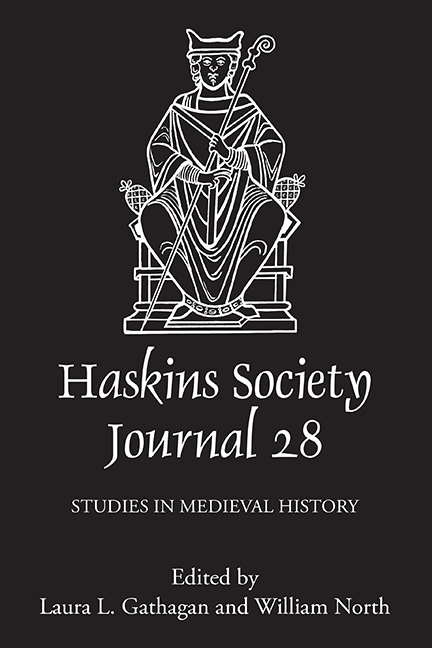Book contents
- Frontmatter
- Contents
- List of Figures and Tables
- Editors' Note
- Abbreviations
- 1 Under the ‘Romans’ or under the Franks? Venice between Two Empires
- 2 Lost and Found: Eadmer's De reliquiis sancti Audoeni as a Cross–Channel Solution to the Canterbury–York Dispute
- 3 Of Lost Libraries and Monastic Memories: Creating the Eleventh-Century Novalesa Miscellany
- 4 The Place of Henry I in English Legal History
- 5 ‘Goliath Thought David Rather Boastful’: Royal Masculinity in Kingless Societies
- 6 Well-Behaved Women? Agnès of Baudement and Agnès of Braine as Female Lords and Patrons of the Premonstratensian Order
- 7 ‘Videmus nunc per speculum’: The Mysticism and Naturalism of the Twelfth-Century imago mundi
- 8 The Norman Kings of Africa?
- 9 Punishing Adultery: Private Violence, Public Honor, Literature, and the Law
8 - The Norman Kings of Africa?
Published online by Cambridge University Press: 23 August 2019
- Frontmatter
- Contents
- List of Figures and Tables
- Editors' Note
- Abbreviations
- 1 Under the ‘Romans’ or under the Franks? Venice between Two Empires
- 2 Lost and Found: Eadmer's De reliquiis sancti Audoeni as a Cross–Channel Solution to the Canterbury–York Dispute
- 3 Of Lost Libraries and Monastic Memories: Creating the Eleventh-Century Novalesa Miscellany
- 4 The Place of Henry I in English Legal History
- 5 ‘Goliath Thought David Rather Boastful’: Royal Masculinity in Kingless Societies
- 6 Well-Behaved Women? Agnès of Baudement and Agnès of Braine as Female Lords and Patrons of the Premonstratensian Order
- 7 ‘Videmus nunc per speculum’: The Mysticism and Naturalism of the Twelfth-Century imago mundi
- 8 The Norman Kings of Africa?
- 9 Punishing Adultery: Private Violence, Public Honor, Literature, and the Law
Summary
In 1148, a navy under the command of Roger II, the Norman king of Sicily, sailed from Palermo to the North African city of Mahdia, which at the time was controlled by a dynasty of Muslim rulers called the Zirids. Once a nomadic Berber people, the Zirids had forged and ruled a kingdom in the region of Ifrīqiya – now Tunisia, eastern Algeria, and western Libya – during the eleventh and twelfth centuries, as vassals of the Fatimid caliphate of Egypt. However, the Zirid emirs of Ifrīqiya were unable to stop the advancing forces of King Roger, whose conquests led to the formation of the Norman ‘Kingdom of Africa’ (1148–60). The Normans governed these African territories into the reign of Roger's successor William I ‘The Bad’, who came to power in 1154. The rule of the Normans in Ifrīqiya was short-lived, though, as civil unrest in 1156–57 brought an end to Norman rule in all of its African cities except Mahdia, which later fell to the Almohads in 1160.
During the time of their rule in Africa, Roger II and William I governed a complex administration that incorporated an ethnically and religiously diverse group of people. The Norman kings of Sicily ruled their African territories through a combination of Norman officials and local Berber chieftains. The Norman navy was commanded by an Armenian Christian who made alliances with Muslim leaders throughout the Mediterranean. Jewish traders in Ifrīqiya dealt in luxury goods from Egypt, wheat from Sicily, and gold from sub-Saharan Africa. Under the employ of the Normans was an Andalusian Muslim court geographer named Muhammad al-Idrisi, who crafted world maps that spanned from China to Iceland. Presiding over such a diverse and dynamic group of peoples, perceptions of Roger II and William I's rule was equally diverse. Latin and Arabic sources testify to the variety of ways in which medieval authors viewed Norman governance, particularly in Ifrīqiya.
At the heart of the varied perceptions of the Normans in these sources is the use of the title rex Africe (‘king of Africa’). Roger II never adopted the epithet rex Africe in his royal charters in the years following his African conquests (1148–54), instead preferring to use the title that Pope Innocent II bestowed on him: ‘king of Sicily, of the duchy of Apulia, and of the principality of Capua’.
- Type
- Chapter
- Information
- The Haskins Society JournalStudies in Medieval History, pp. 143 - 166Publisher: Boydell & BrewerPrint publication year: 2017
- 1
- Cited by

